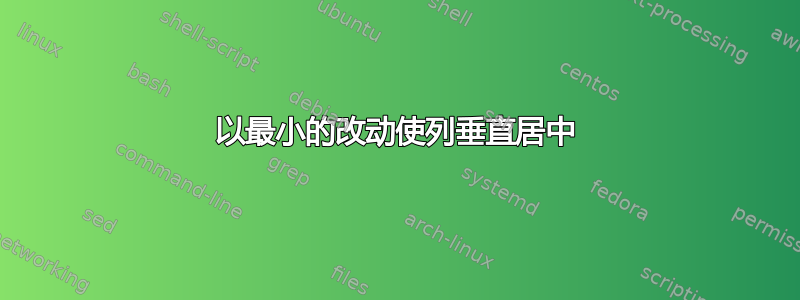
我永远不会原谅 TeX 让垂直居中表格变得如此困难。
多年来(实际上,是的,多年来)我一直在尝试正确格式化如下的表格。这是我提交前的最后一次尝试。我已经做好了提交丑陋表格的心理准备。
有人有微创有什么技巧可以让第一列正确垂直居中?是什么导致了这个问题?
当前的表格看起来就像是一场彻底的事故(红色矩形突出显示了混乱的列)。
造成混乱的 TeX 代码如下:
\usepackage{booktabs}
\usepackage{multirow}
% add spacing for table
{\def\arraystretch{1.3}\tabcolsep=10pt
% Table based on Springer template
\begin{table}[ht]
\footnotesize % small font size (source: http://tex.stackexchange.com/questions/56008/different-sizes-of-font-available-in-table)
% table caption is above the table
\caption[Mitigation situations]{Mitigation situations}
\label{tab:mititgation_phase} % Give a unique label
% For LaTeX tables use
\begin{tabular}{m{3cm}m{11cm}} %
\hline\noalign{\smallskip}
\textbf{} & \textbf{Vulnerability of an existing or planned future supply chain}\\
\noalign{\smallskip}\hline\noalign{\smallskip}
\multirow{4}{3cm}{\textbf{Various forms of supplier concentration}}
& Dependencies on a single shared supplier on a sub-tier level \\
& Geographical concentration of sub-tier suppliers \\
& Undesirable levels of suppliers depending on specific countries or other political unions (relevant in cases of tariffs etc.) \\
& Limited number of available alternative suppliers or trends towards such a market consolidation \\
\hline
\multirow{2}{3cm}{\textbf{Various forms of undesirable supply chain participants}}
& Dependencies on previously unknown, undesirable sub-tier suppliers (legal risks, quality risks, availability risks, blacklisted by authorities, unsustainable, unethical etc.) \\
& Dependencies on individual sub-tier suppliers located in high-risk areas (e.g. prone to natural disasters) \\
\hline
\multirow{3}{3cm}{\textbf{Various forms of overlapping, competing or otherwise interfering supply chains}}
& Seemingly unrelated industries competing for the same resources as the OEM and potentially negatively impacting supply \\
& Dependencies on the health of a supply chain that produces complementary parts (see the case study in Section~\ref{sec:2011_thailand_floods} where demand for Intel's chips was impacted by an HDD shortage) \\
& Competitors and otherwise risky (e.g. financially unstable) businesses using (and potentially negatively impacting) identical supply chain participants \\
\hline
\textbf{Dependencies on problematic parts or materials} & E.g. dependencies on parts or materials on a sub-tier level with uncertain supply (e.g. rare earth elements that are mostly mined in China) \\
\noalign{\smallskip}\hline
\end{tabular}
\end{table}
} % closing bracket for extra spacing for table
答案1
您已加载booktabs,但未使用它,并且正在使用array但未加载它,并且使用multirow阻止了垂直对齐。
您可以大大简化标记:
\documentclass[a4paper]{article}
\addtolength\textwidth{80pt}% since you specified the table width and it doesn't fit otherwise
\usepackage{booktabs,array}
\begin{document}
% Table based on Springer template
\begin{table}[htp] % you almost always want p
\footnotesize % small font size (source: http://tex.stackexchange.com/questions/56008/different-sizes-of-font-available-in-table)
% table caption is above the table
\caption[Mitigation situations]{Mitigation situations}
\label{tab:mititgation_phase} % Give a unique label
\begin{tabular}{>{\raggedright}m{3cm}>{\parskip=.5\baselineskip}m{11cm}} %
& \textbf{Vulnerability of an existing or planned future supply chain}\\
\toprule
\textbf{Various forms of supplier concentration}
&
Dependencies on a single shared supplier on a sub-tier level
Geographical concentration of sub-tier suppliers
Undesirable levels of suppliers depending on specific countries or other political unions (relevant in cases of tariffs etc.)
Limited number of available alternative suppliers or trends towards such a market consolidation
\\
\midrule
\textbf{Various forms of undesirable supply chain participants}
&
Dependencies on previously unknown, undesirable sub-tier suppliers (legal risks, quality risks, availability risks, blacklisted by authorities, unsustainable, unethical etc.)
Dependencies on individual sub-tier suppliers located in high-risk areas (e.g. prone to natural disasters)
\\
\midrule
\textbf{Various forms of overlapping, competing or otherwise interfering supply chains}
&
Seemingly unrelated industries competing for the same resources as the OEM and potentially negatively impacting supply
Dependencies on the health of a supply chain that produces complementary parts (see the case study in Section~\ref{sec:2011_thailand_floods} where demand for Intel's chips was impacted by an HDD shortage)
Competitors and otherwise risky (e.g. financially unstable) businesses using (and potentially negatively impacting) identical supply chain participants
\\
\midrule
\textbf{Dependencies on problematic parts or materials}
&E.g. dependencies on parts or materials on a sub-tier level with uncertain supply (e.g. rare earth elements that are mostly mined in China)
\\
\bottomrule
\end{tabular}
\end{table}
\end{document}




